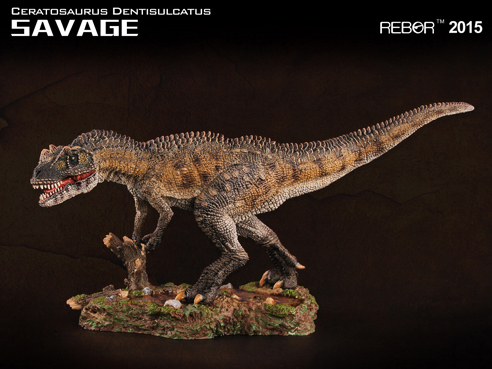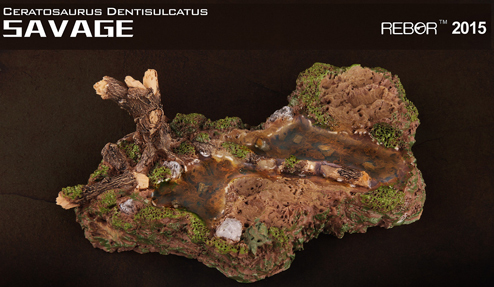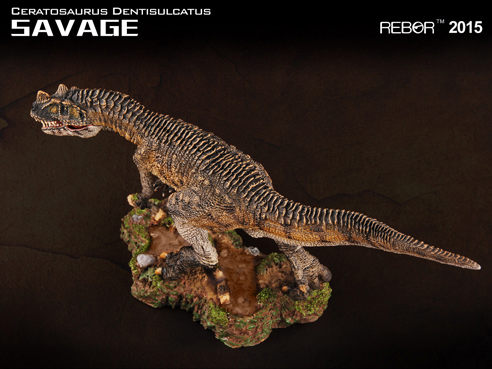“Savage” The New Ceratosaurus Model Countdown – Two Weeks!
Rebor Ceratosaurus “Savage” Available Around Mid April
The next edition in the highly acclaimed Rebor replica series will be arriving at Everything Dinosaur shortly. A spokesperson for the company stated that the shipment of 1:35 scale Ceratosaurus replicas could be at the company’s warehouse as early as the middle of April. The Ceratosaurus is the fourth replica in the Rebor Collection to be introduced, it is also the fourth theropod dinosaur ( it joins Yutyrannus, Tyrannosaurus rex and Utahraptor). Unlike the other meat-eating dinosaurs in this very collectible series, the genus Ceratosaurus actually consists of a number of species.
Rebor Ceratosaurus
At least six different species have been assigned although a number are regarded as nomen dubium, this contrasts with the other carnivorous dinosaurs so far depicted by Rebor which only have one species within their genus. It could be argued that there is a second species within Tyrannosaurus (T. bataar), but at Everything Dinosaur we tend to support the hypothesis that although North American tyrannosaurids are descended from Asian tyrannosaurs, the distinct genus for Tarbosaurus remains valid.
New Rebor Replica on the Block – 1:35 Scale Ceratosaurus
Picture credit: Rebor
“Savage”
The Ceratosaurus has been nick-named “Savage” and it is a representation of one of the largest of the Ceratosaurus species named so far (C. dentisulcatus). This species was erected in 2000 A.D. after a re-assessment of a particularly large specimen found in the famous Cleveland-Lloyd quarry in Utah (Morrison Formation). Although believed to represent a single dinosaur, the bones that were used to establish this new, larger species of Ceratosaurus were found over a period of many years and from a number of locations (but within the same horizon), within the dig site.
It has been estimated that Ceratosaurus dentisulcatus could have reached a length around 8.5 metres, one third longer than the first species of Ceratosaurus named by Othniel Charles Marsh back in the mid 1880s. Like all the ceratosaurs, it had a relatively long tail compared to the rest of its body.
Marsh commented on the resemblance of the tail to a crocodile’s when he studied the bones that would be assigned to C. nasicornis, the first species to be named. He suggested that this dinosaur would have been very much at home in the swampy regions of the Morrison and the tail would have helped this dinosaur to swim very effectively across the many large rivers and lakes that existed in this part of the United States back in the Late Jurassic.
The Skilfully Constructed Base Reflects the Swampy Home of Ceratosaurus
Picture credit: Rebor
A Superb Display Base
The hand-painted base boasts realistic plants, logs, mud effect and even a puddle that’s made of transparent resin to create the impression of real water. Although, Ceratosaurus dentisulcatus is known from a collection of bones thought to represent a single animal, all the material ascribed to this species come from the Brushy Basin Member of the Morrison Formation. This is the youngest member of the Morrison, with strata dating from around 148 million years ago. At this time, this part of the world was more humid and wetter than previously, desert areas had given way to lush, verdant habitats.
It seems likely that Ceratosaurus dentisulcatus was a dinosaur that lived in a wetland environment. The details on the replica’s base reflect this and Rebor must be credited for the care and attention they have lavished on the development of an accurate base for their replica.
Intriguingly, although some cranial material has been ascribed to C. dentisulcatus, it is not known for sure whether this dinosaur actually possessed that signature nasal horn that gives this genus its name. These bones have not been found, as far as we at Everything Dinosaur are aware.
Why Ceratosaurus dentisulcatus?
We asked our chums at Rebor why this particular species rather than the better known Ceratosaurus nasicornis? C. nasicornis is the species that we at Everything Dinosaur based our own Ceratosaurus fact sheet upon and the first species to be identified within the genus.
A spokesperson for Rebor stated that there were several reasons behind their choice. Firstly, C. dentisulcatus was a more massive and robust animal when compared to what is known about C. nasicornis. The tibia (shinbones) for example are six centimetres longer and other direct comparisons indicate that Ceratosaurus dentisulcatus was a bigger and more formidable carnivore. Rebor are aware that the fossil material first used to describe Ceratosaurus nasicornis very probably represents a sub-adult and that C. nasicornis could well have been much bigger and heavier than stated.
Different Ceratosaurus Species
However, when you take into account those more recurved and substantially bigger teeth associated with C. dentisulcatus when compared to other Ceratosaurus species, you can understand the appeal of this particular Ceratosaurus species to a model manufacturer. Incidentally, it is the larger and strongly recurved teeth in the premaxilla (upper jaw) and the front three teeth of the dentary (lower jaw) with their very visible parallel grooves running down their medial surface (inside facing) that give this species its name. We speculate that these grooves helped inflict maximum damage with bites and that the grooves could have helped blood flow from wounds thus hastening the demise of victims – very nasty, the Dinosauria equivalent of “dum-dum” bullets!
A Comparison of Ceratosaurus magnicornis skull material with Ceratosaurus dentisulcatus
Picture credit: Utah Geological Survey/Everything Dinosaur
In the diagram above, the left lateral views of skull material from C. magnicornis and C. dentisulcatus are compared. Although the skull of C. magnicornis is more compressed and these diagrams are not to scale, the proportionately bigger and more curved teeth of Ceratosaurus dentisulcatus can be made out. Ceratosaurus magnicornis, which is known from the lower part of the Brushy Basin Member of the Morrison Formation, but this time from exposures located in Colorado (Fruita, Colorado), was very probably larger than Ceratosaurus nasicornis, but perhaps not as big as C. dentisulcatus.
Comparing the Size of Dinosaurs
Direct size comparisons are difficult, as the holotype material associated with C. magnicornis, just like C. nasicornis may represent a not fully grown animal. What is interesting is that the nose horn on C. magnicornis is bigger, so it has been concluded that if Ceratosaurus dentisulcatus is larger still, then its nose horn was probably big too. A large nose horn can be clearly seen on the Rebor replica.
A Dorsal View of the Rebor Ceratosaurus Model
Picture credit: Rebor
“Savage”, the 1:35 scale Rebor Ceratosaurus replica is going to be available from Everything Dinosaur around the middle of April. Could Ceratosaurus finally be stepping out into the limelight and join Allosaurus and Saurophaganax in being regarded as an apex predator?
To view Everything Dinosaur’s Rebor range of models: Rebor Dinosaur and Prehistoric Animal Models.





